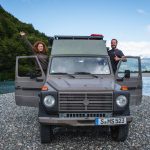The small village of Quilotoa in northern Ecuador is a paradise for hiking enthusiasts and nature lovers. Located only about a three-hour drive from Quito, the region attracts visitors with its spectacular crater lake set amidst an impressive volcanic landscape. Particularly popular among travelers to Ecuador who enjoy hiking is the multi-day Quilotoa Loop – a circular hiking route that connects various small villages in the region, offering insights into the culture and nature of the Andes. However, even for those who don’t plan on embarking on a multi-day hike and prefer day trips instead, a visit is well worth it. The Quilotoa Crater Hike, which circles the caldera of the Quilotoa Crater, is one of the most beautiful day hikes in Ecuador . It offers breathtaking views, fascinating insights into the geological history of the region, and an unforgettable nature experience.

Quilotoa Crater Hike: Circular Trail Along the Crater Rim

The impressive Quilotoa Crater is located at just under 4,000 meters in the Ecuadorian Andes. The crater was formed by a massive volcanic eruption that likely occurred around the year 1280. Today, the crater, which is 3 kilometers in diameter, contains a lake approximately 250 meters deep. The lake’s color varies depending on the position of the sun, ranging from deep blue to vibrant turquoise to intense green.
The nearby village of Quilotoa, which shares its name with the crater, is the ideal starting point for hikers and nature enthusiasts looking to explore the stunning landscape surrounding the crater. The volcanic scenery, spectacular views of the shimmering crater lake, and the surrounding mountain peaks make a trip to Quilotoa an unforgettable destination and, for us, one of the most beautiful spots in Ecuador.
Start of the Circular Hike in Quilotoa – Clockwise Around the Crater
A narrow hiking trail of just over 11 kilometers circles the Quilotoa Crater Lake. Our starting point is the small village of Quilotoa, sharing the same name as the crater. From here, we begin the hike clockwise. The first few kilometers of the route are mostly flat, with only occasional short ascents and descents, none of which are steep. The trail winds predominantly along the rim, allowing us to enjoy an uninterrupted view of the crater lake and the surrounding mountain peaks almost the entire time. The lake itself shimmers in the sunlight, appearing deep blue at times and greenish at others. We frequently pause to take in the breathtaking views.
Although Quilotoa itself was crowded with tourists, we encountered only a few people on the hiking trail. Most visitors stay near the small viewing platform or hike down the path to the lake. We enjoyed the tranquility and appreciated that only a handful of hikers crossed our path throughout the entire hike.



3914 Meters – Challenging Ascent to the Highest Point
Shortly after the halfway point, the trail climbs steeply as we approach the highest point of the crater rim. While the ascent is steep in parts, it is not particularly long. However, the thin air at nearly 4,000 meters makes progress slow. Even though we’ve already spent several days at altitude and have done shorter hikes, we can feel how the elevation challenges our bodies.

But the view awaiting us at the top is more than worth the effort. From the highest point, we are rewarded with a breathtaking 360-degree panorama – the glittering surface of the lake, the surrounding peaks, and the trail we’ve already covered. To our delight, the wind subsides a bit, allowing us to launch the drone. It turns out we didn’t carry it all this way for nothing. At the same time, from up here, we can also see how much of the trail still lies ahead and that there will be one last ascent before we return to the village.
Back to Quilotoa: The Final Ascent on the Quilotoa Crater Hike
We continue hiking. After the highest point, the trail leads downhill for quite a while – and in some sections, it’s quite steep. I regret having left my trekking poles in the car, as they would have been very helpful on this hike. The final ascent before reaching Quilotoa is not as steep as the previous climb, but the altitude and the kilometers we’ve already covered are taking their toll. As always, the altitude affects me more than it does Mats. While he also feels the strain, it’s mostly me who needs to stop for short breaks to regain strength. The last kilometer feels like it stretches on forever. As the first houses of Quilotoa come into view, the sky begins to cloud over. A thick bank of clouds drifts over the lake and lingers on the surrounding mountains. Despite the exhaustion, a sense of joy mixes in, knowing we’ve just completed one of the most beautiful circular hikes of this trip.
Descent to the Crater Lake: An Extra Detour You Shouldn’t Miss

For those who still have energy left after hiking around the crater, there’s the option to descend to the lake. There are two trails: the first starts directly in the village of Quilotoa, while the second begins a bit farther away near the village of Shalalá. The circular crater hike passes by both trails, making it easy to combine them. Both paths are extremely steep, so a bit of stamina is needed at this altitude to tackle the climb back up. You should plan at least half an hour for the ascent. The trail from Quilotoa is the more popular one, with most visitors taking this route down to the lake. At the bottom, you’ll find kayaks for rent, restrooms, and for those who find the return trip too exhausting, there’s the option to ride a horse back up for $20.
We didn’t combine the descent with the circular hike around the Quilotoa Crater but instead took the trail from the village of Quilotoa the day before. The scenery and the view of the steep crater walls paired with the shimmering water are absolutely breathtaking. We definitely recommend making the detour to the lake.
Costs, Accommodation, and Food: Practical Information for Your Visit
Food on the Quilotoa Crater Hike
Along the 11-kilometer hike, there are a few small huts selling water, soda, or snacks. On our hike, only one of them was open. Therefore, it’s better to bring enough water and provisions yourself and not rely on being able to purchase something along the way.
Accommodation and Campsites in Quilotoa: Tips for the Night
The small village of Quilotoa is not only popular among international travelers but also attracts many locals. Due to its proximity to Quito, the crater lake is an ideal destination for city dwellers looking for a getaway. As a result, the village has a strong tourist presence: around the parking areas, you’ll find numerous restaurants, souvenir and snack stalls, as well as several hostels and hotels. However, you won’t find a campground or a designated spot for campers.
For travelers with their own vehicle, the parking lot in the village is the best option for an overnight stay. We chose the lower parking lot and asked the locals if we could park our vehicle a bit away from the houses – this wasn’t a problem at all. The public restrooms are free to use but only open during the day. If, like us, you’re traveling in a camper, be prepared for very limited infrastructure for campers here. Nevertheless, the village is a great starting point for the hike around the crater and the descent to the lake. For one night, the parking lot is definitely a decent option for accommodation.
Costs for the Quilotoa Crater Hike: Entrance Fee and Additional Information
At the entrance to the village, a ticket costing $2 USD per person must be purchased. This ticket does not appear to have any validity restrictions. There is no additional fee for camping. We were never asked to show the ticket after purchasing it.
Tour Details at a Glance
Length of the hike: 11,1 km
Höhendifferenz gesamt: 330 Meter
Difficulty: Medium
Trail Conditions and Trail SignsThe trail is consistently well-maintained. At intersections, the direction is clearly marked.
Other: Although the hike itself is not particularly challenging, the altitude should not be underestimated. It makes the 11 kilometers quite tiring and energy-draining. Be sure to pack sunscreen and plenty of water.
ACCLIMATIZATION FOR HIKING AT HIGH ALTITUDES
Anyone hiking in the Andes or other high-altitude regions must be prepared for the challenges of altitude. At around 2,500 meters above sea level, the oxygen levels in the air decrease, which puts the body under unique strain. Proper acclimatization is crucial to help the body adjust to these new conditions and to prevent altitude sickness.
Ascend slowly: Above 2,500 meters, increase sleeping altitude by only 300–500 meters per day
Drink plenty of water: Avoid dehydration
Take a rest day: Alle 1000 Meter Aufstieg einen Tag Pause machen
Take symptoms seriously: Headaches, nausea, or dizziness can be signs of altitude sickness.

